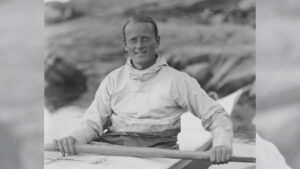In the summer of 1965, Tété-Michel Kpomassie became the first African to explore Greenland. He was 24 on the day that he stepped onto the dock at Qaqortoq, on Greenland’s southern coast. But his arctic journey had actually begun some seven years prior, in the West African town of Lomé, Togo.
Now approaching 81 years of age, Kpomassie is packing up his Parisian apartment and heading back to northern Greenland, where he intends to live out his gloaming.

Kpomassie learned to ice fish from the Greenlandic Inuit. Photo: Tété-Michel Kpomassie
The story of an African and Greenland
Kpomassie’s fabled life story starts with a bit of chance and a book. The young Togolese was 16 when he bought anthropologist Robert Gessain’s Les Esquimaux du Groenland à l’Alaska (The Eskimos from Greenland to Alaska) from a small bookshop in Lome. Immediately, the subject captivated him, and within a year he’d run away from home in pursuit of the Arctic.

Photo: Tété-Michel Kpomassie
His trajectory to Greenland was anything but direct. He traveled along the West Coast of Africa, from Côte d’Ivoire in the south to the northern crest of Algeria, eventually crossing into Europe. Ther,e he stayed for some time before disembarking for Greenland via Copenhagen.
“I took my time to step out,” he recalled in an interview with The Guardian. “I suspected none would have met a black man before. When I did, everyone stopped talking, all were staring. They didn’t know if I was a real person or wearing a mask. Children hid behind their mothers. Some cried, presuming I was a spirit from the mountains.”

Photo: Tété-Michel Kpomassie
Kpomassie found his true home in Greenland’s northern reaches, where the Inuit culture that he’d pored over in a book as a boy was very much alive. Over the next 18 months, Greenland’s first African transplant learned to ski, mush, ice fish, hunt, and flourish in the tundra.
He returned to Togo in late 1966, reluctant but determined. He adapted the journal he’d kept into a tome, and taught himself several languages through correspondence with friends he’d made on his pilgrimage.

Photo: Tété-Michel Kpomassie
Kpomassie then went on to give numerous lectures about his experience in halls and classrooms throughout Africa and Europe. And he settled down in Paris and raised a family, returning to Greenland on three occasions in that time. “[A]ll the while I knew where I ultimately needed to end up,” he said.
His seminal book, “An African in Greenland,” was published in France in 1977 and reproduced in English in 1981. It earned him France’s Prix Littéraire Francophone International award, also in 1981, and has since been translated into eight languages.

Kpomassie’s seminal text, ‘An African in Greenland,’ was published in French in 1977 and translated to English in 1981. Photo: Jerry Kobalenko
Kpomassie intends to close his story much as it began — with a book and a bit of chance. “I’ll have a dog sled and huskies,” the explorer remarked. “I’ll find myself a small fishing boat. And here I’ll happily spend my remaining days, and finally find time to write my second book, about my childhood in Africa.”

Kpomassie at his home in Paris. Photo: Anne Holland






